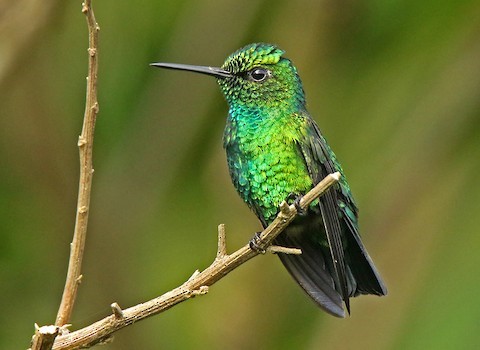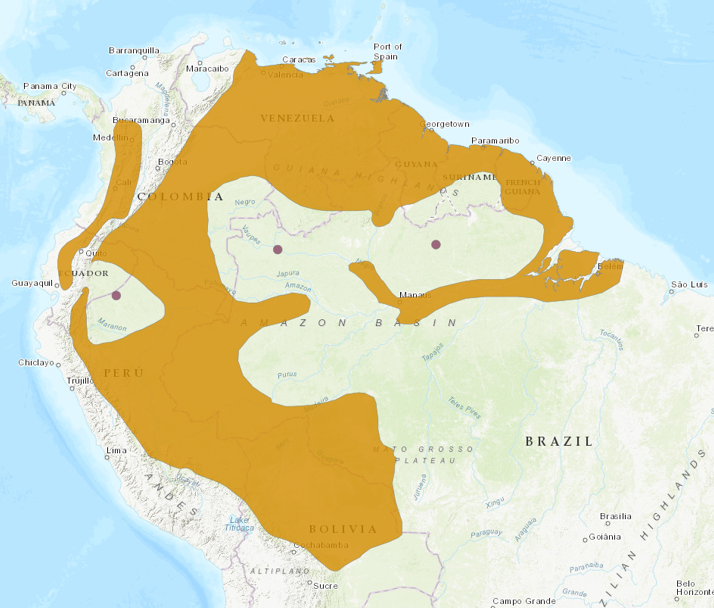Birdfinding.info ⇒ Fairly common but local across much of its South American range. In Amazonia, it likely benefits from patchy forest clearing, and can be found in the gardens of many ecolodges—particularly in eastern Ecuador and Peru. Most abundant on the ABC Islands, where it is the predominant hummingbird. Easy to find on Aruba at sites such as the Bubali Bird Sanctuary and Spaans Lagoon.
Blue-tailed Emerald
Chlorostilbon mellisugus
Lowlands of northern South America, Amazonia, and the southern Caribbean.
Inhabits semiopen habitats such as savannas, riparian woodlands, and forest clearings east of the Andes from eastern Colombia across Venezuela and the Guianas to western Maranhão, and south to southern Bolivia, southern Mato Grosso, and Tocantins.
Also occurs in more arid habitats on the ABC Islands, Isla Margarita, and northwestern Trinidad.
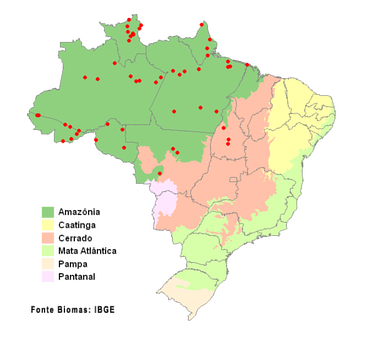
Brazilian records from © WikiAves
Identification
A small hummingbird with shallowly forked tail and medium-to-long, nearly straight, black bill.
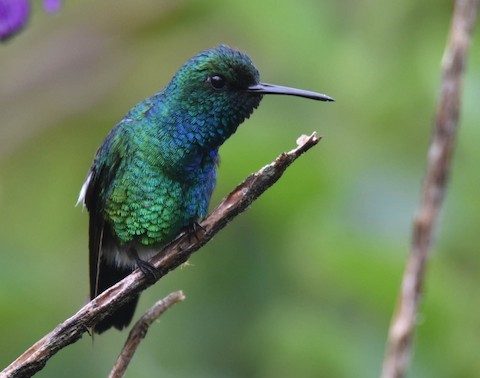
Blue-tailed Emerald, male. (Patria, Peru; December 11, 2015.) © Tini and Jacob Wijpkema
Male is glittering green with a black tail—which shows a bluish tinge in strong light. Also has puffy white leggings that are not always easy to see.
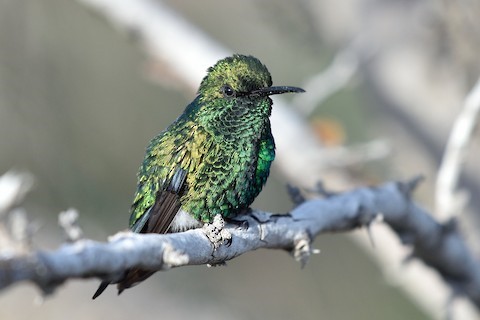
Blue-tailed Emerald, male. (Spaans Lagoon, Aruba; July 4, 2017.) © Michiel Oversteegen
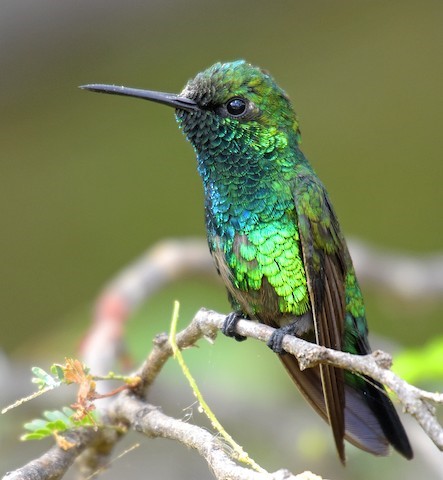
Blue-tailed Emerald, male. (Bubali Bird Sanctuary, Aruba; April 14, 2017.) © Steven Mlodinow

Blue-tailed Emerald, male. (Arikok National Park, Aruba; October 19, 2009.) © Tom Murray
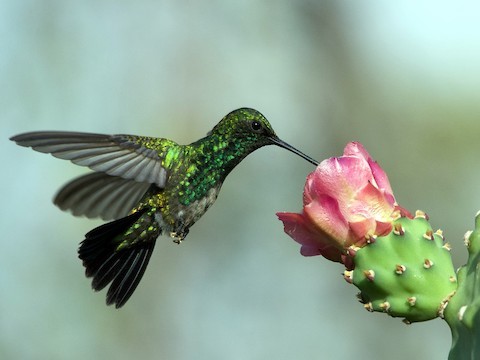
Blue-tailed Emerald, male. (Spaans Lagoon, Aruba; April 26, 2018.) © Michael Tromp
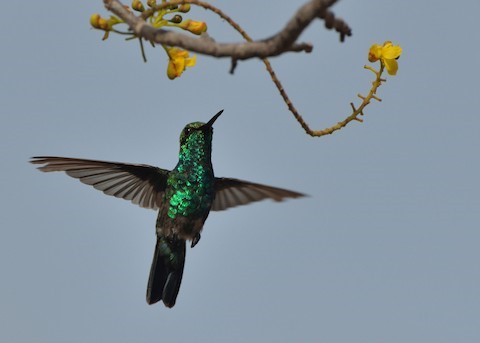
Blue-tailed Emerald, male showing notch in tail. (Spaans Lagoon, Aruba; July 10, 2019.) © Michiel Oversteegen
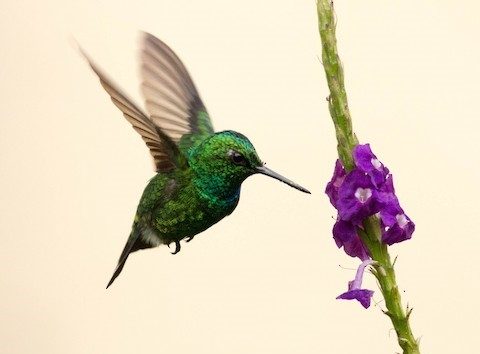
Blue-tailed Emerald, male. (Amazonía Lodge, Madre de Dios, Peru; July 18, 2017.) © Paul Fenwick

Blue-tailed Emerald, male showing puffy white leggings. (Amazonía Lodge, Madre de Dios, Peru; July 18, 2017.) © Paul Fenwick
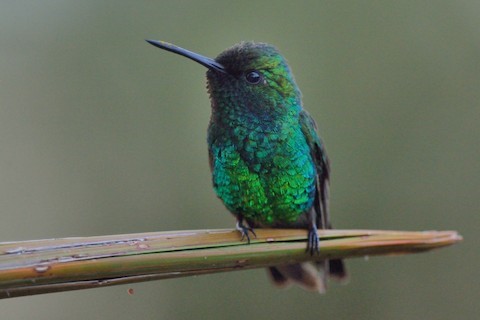
Blue-tailed Emerald, male. (Spaans Lagoon, Aruba; March 10, 2019.) © Michiel Oversteegen
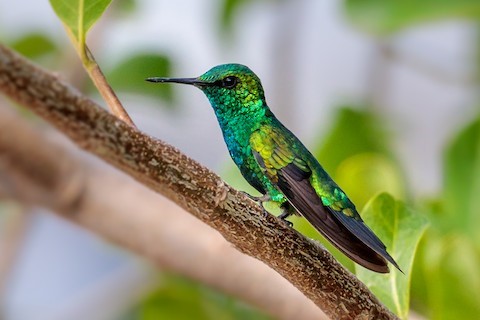
Blue-tailed Emerald, male showing atypical golden patches on its head and wings. (Kralendijk, Bonaire; August 12, 2018.) © Gerard Cachon
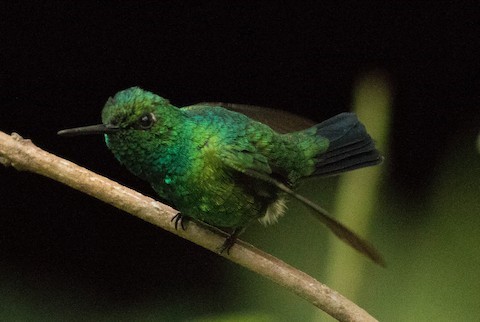
Blue-tailed Emerald, male. (Amazonía Lodge, Madre de Dios, Peru; July 18, 2017.) © Paul Fenwick
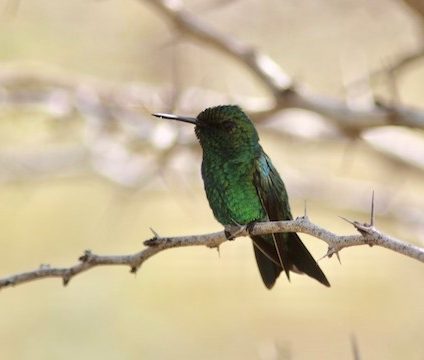
Blue-tailed Emerald, male showing shallow fork in tail. (Curaçao; March 15, 2018.) © Pierre Bergeron
Female is green above and whitish below with a blackish cheek stripe and white post-ocular streak. Its tail is notched and black (or blue-black) with narrow white corners.
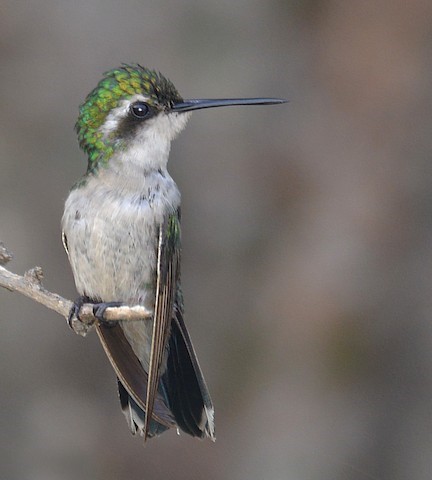
Blue-tailed Emerald, female—note white corners on tail. (Tierra del Sol, Aruba; April 16, 2017.) © Steven Mlodinow
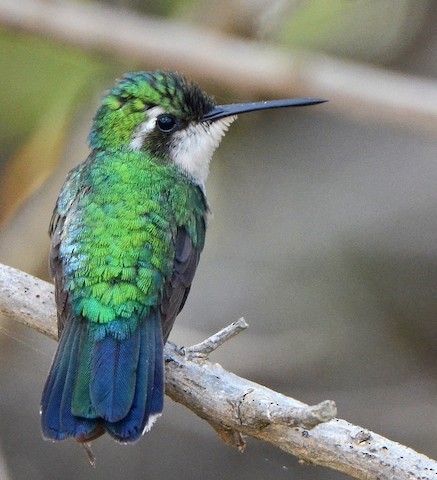
Blue-tailed Emerald, female showing blue tinge on tail. (Bubali Bird Sanctuary, Aruba; February 6, 2014.) © Steven Mlodinow

Blue-tailed Emerald, female. (Bubali Bird Sanctuary, Aruba; September 27, 2016.) © Michiel Oversteegen
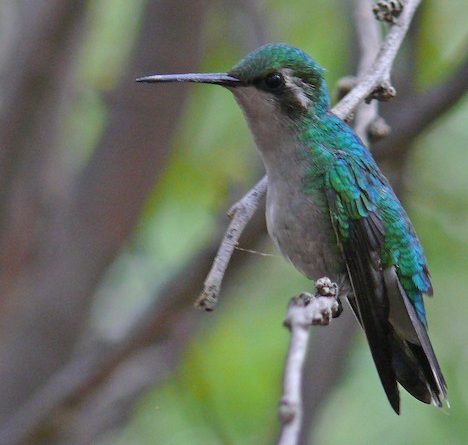
Blue-tailed Emerald, female. (Tierra del Sol, Aruba; October 30, 2007.) © Steven Mlodinow

Blue-tailed Emerald, female. (Tierra del Sol, Aruba; April 16, 2017.) © Steven Mlodinow
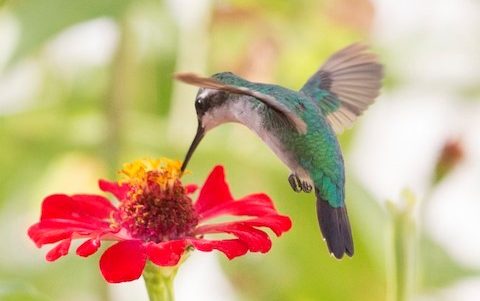
Blue-tailed Emerald, female. (Cata, Aragua, Venezuela; August 3, 2019.) © Oswaldo Hernandez
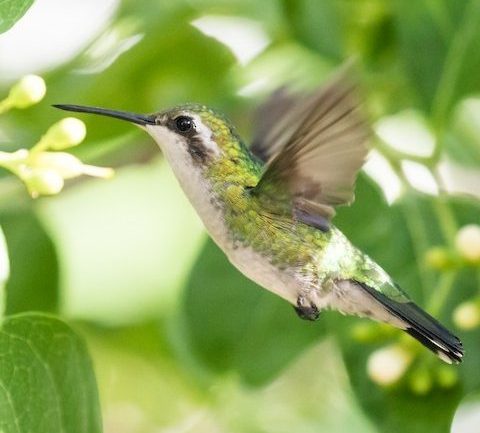
Blue-tailed Emerald, female. (Kralendijk, Bonaire; August 12, 2018.) © Gerard Cachon

Blue-tailed Emerald, immature male molting into adult plumage. (Spaans Lagoon, Aruba; April 8, 2013.) © Steven Mlodinow
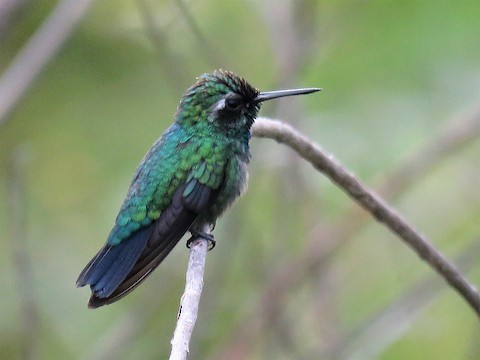
Blue-tailed Emerald, male in late stage of molt into adult plumage showing black and white facial markings: remnants of the immature plumage. (Serra do Tepequem, Roraima, Brazil; December 20, 2017.) © Örjan Sjögren
Young males are potentially confusing as they begin with female-like plumage then turn green in patches.
At the early stages they resemble certain mangoes, and at the later stages they become nearly all-green with black and white facial markings.
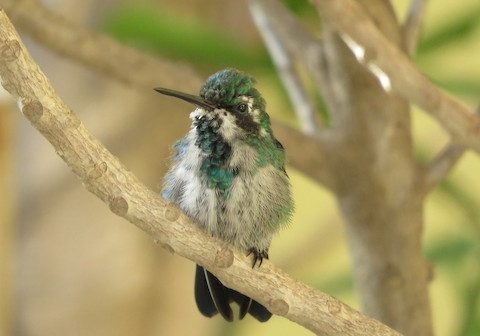
Blue-tailed Emerald, immature male molting into adult plumage. (Oranjestad, Aruba; November 12, 2015.) © Aaron Boone
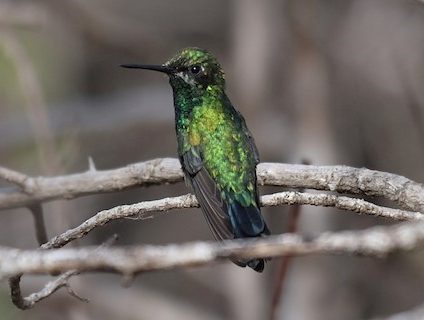
Blue-tailed Emerald, male in late stage of molt into adult plumage showing black and white facial markings: remnants of the immature plumage. (Bubali Bird Sanctuary, Aruba; July 7, 2019.) © Michiel Oversteegen
Cf. Blue-chinned Sapphire. Blue-tailed Emerald and Blue-chinned Sapphire overlap widely across northern South America, Amazonia, and Trinidad. The males can be extremely similar. The emerald’s bill is black, whereas the sapphire’s varies from red to black, but usually shows at least a tinge of red on the underside. The emerald’s tail is shallowly forked, whereas the sapphire usually has a square tail, although it can also appear notched. In good light, Blue-chinned Sapphire usually has a blue tinge on its chin, but this is not always detectable. Females of the two species are not similar.
Cf. Red-billed Emerald. Blue-tailed and Red-billed Emeralds overlap narrowly in northern Colombia and western Venezuela. They are nearly identical except for the male Red-billed’s lower mandible, which usually shows some red if seen well. Females may be indistinguishable.
Cf. Green-tailed Emerald. Blue-tailed Emerald overlaps with Green-tailed Emerald in northern Venezuela. Males are readily separable based on tail color. Females can be extremely similar: Green-tailed has some green in its tail, but this is not always detectable.
Notes
Polytypic species consisting of six subspecies.
Sometimes considered conspecific with the Western Emerald of the western Andes of Colombia and Ecuador.
References
Ascanio, D., G.A. Rodriguez, and R. Restall. 2017. Birds of Venezuela. Christopher Helm, London.
BirdLife International 2017. Chlorostilbon mellisugus (amended version of 2016 assessment). The IUCN Red List of Threatened Species 2017: e.T22687313A112399190. http://dx.doi.org/10.2305/IUCN.UK.2017-1.RLTS.T22687313A112399190.en. (Accessed August 15, 2019.)
Bündgen, R., G.M. Kirwan, and P. Boesman. 2019. Blue-tailed Emerald (Chlorostilbon mellisugus). In Handbook of the Birds of the World Alive (J. del Hoyo, A. Elliott, J. Sargatal, D.A. Christie, and E. de Juana, eds.). Lynx Edicions, Barcelona. https://www.hbw.com/node/55436. (Accessed August 15, 2019.)
eBird. 2019. eBird: An online database of bird distribution and abundance. Cornell Lab of Ornithology, Ithaca, N.Y. http://www.ebird.org. (Accessed August 15, 2019.)
ffrench, R. 2012. A Guide to the Birds of Trinidad & Tobago (Third Edition). Cornell University Press, Ithaca, N.Y.
Fogden, M., M. Taylor, and S.L. Williamson. 2014. Hummingbirds: A Life-size Guide to Every Species. HarperCollins, New York.
McMullan, M., and T. Donegan. 2014, Field Guide to the Birds of Colombia (Second Edition). Fundación Proaves de Colombia, Bogotá.
Ridgely, R.S., and P.J. Greenfield. 2001. The Birds of Ecuador, Volume II: Field Guide. Cornell University Press, Ithaca, N.Y.
Schulenberg, T.S., D.F. Stotz, D.F. Lane, J.P. O’Neill, and T.A. Parker. 2007. Birds of Peru. Princeton University Press, Princeton, N.J.
van Perlo, B. 2009. A Field Guide to the Birds of Brazil. Oxford University Press, Oxford.
Wells, J.V., and A.C. Wells. 2017. Birds of Aruba, Bonaire, and Curaçao. Cornell University Press, Ithaca, N.Y.
Wikiaves, Esmeralda-de-cauda-azul, https://www.wikiaves.com.br/wiki/esmeralda-de-cauda-azul.
